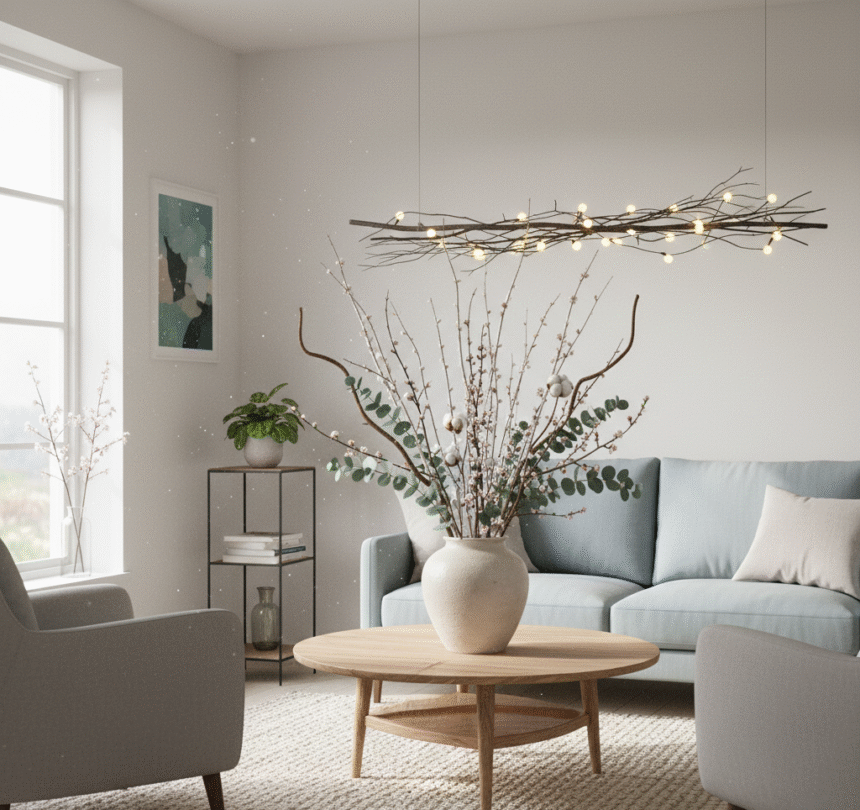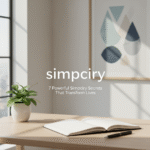What is Pyntekvister?
If you’ve ever admired a cozy Scandinavian home with its effortless blend of simplicity and warmth, chances are you’ve seen pyntekvister at work. The Norwegian term pyntekvister translates to decorative branches, and they play a key role in Nordic interior styling. These natural twigs, often arranged in vases, wreaths, or wall displays, add a soft, organic texture that balances modern minimalism with a touch of nature.
Pyntekvister can be used fresh, dried, or even painted depending on the look you want. Birch, willow, eucalyptus, and cherry blossom branches are some of the most popular choices. Their natural shapes and subtle details make them a versatile design element that fits perfectly in both rustic cottages and sleek, contemporary homes.
Why Pyntekvister Are So Popular in Scandinavian Design
Scandinavian design celebrates simplicity, light, and connection to nature — and pyntekvister embody all three. They bring the outdoors inside, helping to soften modern interiors that can sometimes feel too clean or minimal. A few well-placed branches in a neutral ceramic vase can instantly create visual balance without cluttering the space.
Another reason they’ve become so beloved is sustainability. Instead of relying on artificial decorations, pyntekvister are eco-friendly and biodegradable. Many Norwegians collect branches during seasonal walks, drying and reusing them throughout the year. This approach aligns beautifully with the region’s values of sustainability and conscious living.
Types of Pyntekvister and Their Unique Appeal
Not all pyntekvister are alike. Each type has its own texture, color, and mood. Here’s a quick overview of some common varieties and their decorative value:
| Type of Branch | Visual Appeal | Best For |
| Birch Twigs (Bjørkekvister) | Light color, delicate texture | Minimalist interiors, neutral tones |
| Willow (Seljekvister) | Flexible and curvy | Natural, organic displays |
| Eucalyptus | Silvery-green leaves, fresh scent | Modern or bohemian decor |
| Cherry Blossom (Kirsebærkvister) | Elegant blooms | Spring and festive arrangements |
| Cotton Branches | Soft white buds | Cozy winter styling |
Each type tells a slightly different visual story. For example, birch twigs highlight simplicity, while cherry blossom branches bring an element of freshness and grace. Mixing a few types can create depth and contrast that feels natural yet intentional.
Creative Ways to Use Pyntekvister at Home
Decorating with pyntekvister doesn’t require artistic training — just a little imagination and an eye for balance. Here are some inspiring ideas to bring them into your home:
- In a Vase:
The simplest way to style pyntekvister is to place them in a tall glass or ceramic vase. You can use them alone for a minimalist statement or mix them with dried flowers for more texture. - Wall and Ceiling Decor:
Hung horizontally above a dining table or vertically in an entryway, branches add a touch of rustic charm. Some people wrap them with fairy lights or seasonal ornaments for a cozy effect. - Table Centerpieces:
A few slender twigs paired with candles can turn a plain dining table into a warm, natural gathering spot. - Seasonal Accents:
During Christmas, pyntekvister can be decorated with small ornaments or stars. In spring, add fresh buds or paper flowers to celebrate renewal and light.
These small details create a sense of harmony and authenticity that’s hard to achieve with store-bought decorations.
The Subtle Art of Balance
Using pyntekvister effectively is about understanding balance — both visual and emotional. Too many branches can overwhelm a space, while too few might feel underwhelming. The goal is to complement the existing elements in your room, not compete with them.
A good rule of thumb:
- In bright, minimal spaces, use darker or textured branches for contrast.
- In cozy, warm rooms, lighter twigs help keep the atmosphere open and airy.
This sense of balance reflects the core of Scandinavian design philosophy — simplicity, function, and harmony with nature.
DIY: Creating Your Own Pyntekvist Arrangements
One of the most rewarding parts of using pyntekvister in home decor is that you can create your own arrangements with ease. Whether you’re styling a hallway, dining table, or office corner, the process is simple, relaxing, and highly personal.
Start by choosing your base branches. Look for twigs with interesting textures or slight bends — perfection isn’t the goal here. Trim them to different lengths for a natural look. Place them in a vase with some weight at the bottom (like pebbles or sand) to keep them stable. If you prefer a fuller display, mix in a few dried flowers, grasses, or even feathers for added dimension.
To give your arrangement a personal touch, consider seasonal elements. For example:
- In spring, add budding branches or pastel-colored ribbons.
- In autumn, blend in dried leaves and berries.
- In winter, wrap the branches with delicate fairy lights or metallic accents for a festive sparkle.
The best part? No two arrangements will ever look the same — each one reflects your own creativity and connection to nature.
Seasonal Inspiration: Decorating Year-Round with Pyntekvister
Pyntekvister aren’t limited to one time of year. They can be adapted beautifully to every season, giving your home a constant touch of freshness and warmth.
Spring:
Fresh buds and light-colored branches symbolize renewal. Birch twigs with early leaves or blossoming cherry branches add an airy, hopeful feeling.
Summer:
Combine pyntekvister with wildflowers, lavender, or wheat stalks. This creates a soft, countryside charm that suits both rustic and coastal homes.
Autumn:
Use darker tones — think deep browns, oranges, and reds. Add dried oak leaves, acorns, or clusters of small pinecones for a cozy, earthy effect.
Winter:
This is the perfect time for minimalist magic. White-painted branches or frosted eucalyptus bring elegance to the darker months. Add candles nearby, and you instantly create a calming Scandinavian atmosphere.
By rotating styles through the seasons, pyntekvister keep your decor dynamic without needing to buy new items constantly — a sustainable and budget-friendly approach.
Caring for and Preserving Pyntekvister
To make your pyntekvister last longer, a little care goes a long way. Dried branches are naturally low-maintenance, but they do benefit from occasional dusting. Use a soft cloth or gentle air spray to remove any buildup. Avoid placing them in direct sunlight for long periods, as it can cause fading or brittleness.
If you’re using fresh branches, keep them in clean water and trim the ends slightly every few days. Some types, like eucalyptus, can be air-dried afterward — simply hang them upside down in a cool, dry place until they retain their shape and color.
With proper care, pyntekvister can last months or even years. Many homeowners in Scandinavia treat them as semi-permanent decor pieces, refreshing the arrangement only when nature offers something new.
Combining Pyntekvister with Modern Interior Styles
Pyntekvister blend effortlessly with a variety of decor themes — from classic Nordic minimalism to modern industrial interiors. Here’s how you can pair them effectively:
| Interior Style | How to Use Pyntekvister |
| Scandinavian Minimalist | Simple birch or eucalyptus in a white or neutral vase. |
| Bohemian Chic | Mix branches with dried grasses and colorful textiles. |
| Rustic Farmhouse | Use willow twigs in a vintage jug or wooden container. |
| Modern Industrial | Pair dark-painted branches with metal or glass accents. |
No matter your style, pyntekvister help bridge the gap between structure and softness. They bring in organic form without overwhelming your space — a subtle statement that feels grounded and real.
Conclusion: The Beauty of Simplicity and Nature
Pyntekvister represent more than decoration; they’re a quiet reminder of how beauty often lies in simplicity. In a world filled with fast trends and synthetic designs, these humble branches bring us back to something authentic — nature’s own artistry.
Whether you gather them on a weekend walk, buy them from a local florist, or craft your own arrangement at home, pyntekvister have a timeless charm. They transform everyday spaces into calm, meaningful environments that reflect care, sustainability, and style.
By integrating pyntekvister into your decor, you’re not just adding visual interest — you’re embracing a slower, more mindful way of living. And that’s the essence of Scandinavian design: harmony, light, and the enduring connection between home and nature.
For more quality, informative content, visit writewhiz







